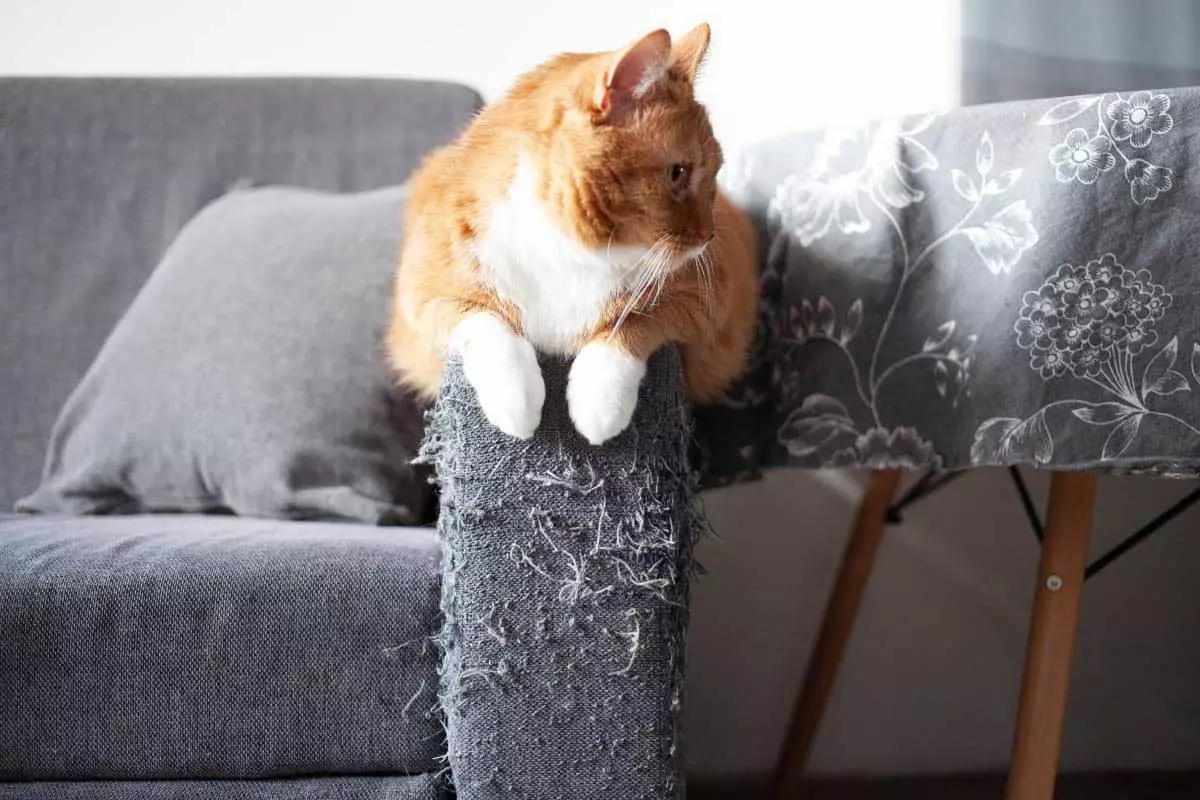Are you tired of finding your favorite couch transformed into your cat’s personal scratching post? You’re not alone.
Many cat owners face the challenge of keeping their furry friends from turning their cherished furniture into shredded remnants. Imagine walking into your living room and instead of seeing claw marks, you see pristine furniture that tells the story of a well-behaved pet.
Sounds like a dream, right? But it doesn’t have to be. In this guide, we’ll unveil simple yet effective strategies to stop your cat from scratching furniture. With just a few changes, you can protect your home and maintain a happy cat. Stick around to discover how you can reclaim your space without compromising your cat’s natural instincts.

Credit: blog.homesalive.ca
Understanding Cat Behavior
Cats scratch furniture to mark territory and keep their claws sharp. Offer scratching posts nearby to redirect this behavior. Use deterrent sprays or covers to protect furniture while training them.
Understanding your cat’s behavior is essential to prevent furniture scratching. Cats scratch for several reasons, and knowing these can help redirect their actions. Observing your cat’s natural instincts gives insights into their scratching habits. This understanding leads to better strategies to protect your furniture.Reasons Cats Scratch
Cats scratch to mark their territory. Scratching leaves both a visual mark and scent from glands in their paws. This behavior is an instinctual way to communicate. Cats also scratch to remove dead layers from their claws. This keeps their claws sharp and healthy. Scratching can be a form of exercise. It stretches their muscles and keeps them agile. Sometimes, cats scratch when they are excited or stressed. Recognizing these reasons helps you manage their behavior effectively.Natural Instincts
Cats have an innate need to scratch. This behavior is part of their survival instincts. In the wild, cats scratch trees to mark territory and sharpen claws. Your indoor cat retains these natural instincts. Scratching is also a way for cats to express themselves. They may scratch more when feeling playful or anxious. Understanding these instincts can guide you in providing alternatives. Offer scratching posts or pads to satisfy their needs.Effective Deterrents
Protect your furniture from cat scratches with effective deterrents. Try placing double-sided tape on targeted areas. Cats dislike the sticky texture, which helps keep them away. Another option is using a citrus spray, as cats tend to avoid citrus scents.
Cats are delightful companions, but their tendency to scratch furniture can be a real headache. Thankfully, there are effective deterrents you can use to protect your cherished items while keeping your feline friend happy. Let’s explore some practical solutions to this common problem.Using Scratch Deterrent Sprays
Scratch deterrent sprays can be a game-changer. These sprays typically contain scents that cats find unpleasant. When applied to furniture, they discourage your cat from scratching. Imagine your couch transformed into an area your cat avoids. It’s important to reapply the spray regularly, especially after cleaning. This ensures the scent remains strong enough to deter your cat. Before choosing a spray, consider if your cat has any allergies or sensitivities. You wouldn’t want to replace one problem with another. Some pet owners have found success with homemade sprays using vinegar or citrus oils. Have you tried any DIY solutions?Protective Covers And Pads
Another effective method is using protective covers and pads. These physical barriers can be placed over your furniture to prevent scratches. They’re especially useful for high-traffic areas like the arms of a sofa. Choose covers that are durable and fit well. Some pads are designed to be aesthetically pleasing, ensuring your decor stays intact. In my experience, placing a scratching post nearby can redirect your cat’s attention. Cats love variety, so mixing covers with other deterrents can be beneficial. Have you noticed your cat’s preferences changing with different setups? These strategies can significantly reduce the damage to your furniture. Every cat is unique, so it’s worthwhile experimenting with different deterrents to find what works best for yours. What strategies have you found most effective in keeping your furniture scratch-free?Alternative Scratching Options
Prevent cats from scratching furniture with scratching posts and pads. Offer cardboard, sisal, or carpeted options. Redirect their attention by placing these near areas they usually scratch.
Cats are delightful companions, but their natural instinct to scratch can wreak havoc on your furniture. Providing alternative scratching options is a game changer. You can direct your cat’s scratching behavior away from your beloved couch and onto something more suitable. Here’s how to do it effectively:Choosing The Right Scratching Post
Selecting the perfect scratching post is crucial. Think about your cat’s preferences. Do they like vertical or horizontal surfaces? Opt for a sturdy post that won’t tip over. Cats love stability. Cover it with materials they enjoy scratching, such as sisal rope or carpet. My cat, Luna, ignored the post until I switched to sisal. Suddenly, it was her favorite spot! Place it near their favorite scratching zones. This way, they can transition easily.Diy Scratch Solutions
You can create scratching alternatives without breaking the bank. Why not try a DIY approach? Use cardboard boxes. Cut them into strips and stack them to make a scratching pad. Wrap old furniture legs with sisal rope. It’s inexpensive and effective. Get creative with wooden planks. Cover them with fabric for a unique scratching board. Which one suits your home and style? You might discover your cat’s new obsession! — When exploring these alternatives, remember to observe your cat’s behavior. Are they engaging with the new options? Adjust accordingly. Your proactive approach can save your furniture and make your feline friend happier.Training Techniques
Cats love to scratch, and furniture often becomes their target. Provide scratching posts to redirect this behavior. Use deterrent sprays and cover furniture with protective materials to keep it safe.
Is your favorite armchair starting to look like a shredded mess? Training your cat to stop scratching furniture can be challenging but not impossible. By utilizing effective training techniques, you can guide your feline friend towards more acceptable behavior.Positive Reinforcement Methods
Positive reinforcement is a powerful tool in changing your cat’s behavior. Reward your cat when it uses a scratching post instead of your couch. Treats, affection, or a quick play session can work wonders. Keep the rewards consistent. If your cat receives a reward every time it uses the scratching post, it will associate the action with positive outcomes. Have you noticed what motivates your cat the most? Use that to your advantage. Cats are smart and will quickly learn that good behavior equals good things. Pay attention to what your cat likes and tailor your rewards accordingly.Redirecting Scratching Behavior
Is your cat ignoring the scratching post? Redirect its attention by placing the post near its favorite scratching spots. Gradually move it to a more suitable location over time. Encourage your cat by gently placing its paws on the scratching post. This shows the cat where it’s supposed to scratch. Does your cat respond to catnip? Sprinkle some on the post to make it more appealing. Observe your cat’s behavior closely. Often, they scratch as part of a routine. Anticipate their scratching times and redirect them to the post before they reach for your furniture. Redirecting isn’t about scolding; it’s about guiding. With patience and consistency, your furniture can become a scratch-free zone.Creating A Cat-friendly Environment
Creating a cat-friendly environment is key to protecting your furniture. Cats need outlets for their natural behaviors. A well-planned environment keeps them happy and your furniture safe.
Strategic Furniture Placement
Place furniture in ways that deter scratching. Keep valuable pieces away from common cat paths. Use furniture covers for added protection. Position scratching posts near areas your cat frequents. Cats often scratch to mark territory. Having posts nearby can redirect this behavior.
Incorporating Play Areas
Designate areas for play to engage your cat. Use toys that mimic prey movement. Interactive toys keep them busy. Rotate toys to maintain interest. Play areas should be comfortable and safe. Cats love climbing, so include vertical spaces. Cat trees or shelves work well.

Credit: www.greensafaris.com
Maintaining Claw Health
Cats often scratch furniture to maintain healthy claws. Provide scratching posts to redirect their attention. Regularly trim their claws to minimize damage and keep your home looking neat.
Maintaining claw health is crucial in preventing your cat from scratching up your furniture. Healthy claws can reduce the need for your feline friend to seek out your couch as a scratching post. By focusing on their claw health, you can create a peaceful coexistence between your cat’s natural instincts and your home furnishings.Regular Claw Trimming
Regular trimming is a simple yet effective way to keep your cat’s claws in check. A pair of cat-specific nail clippers can make the process smoother. Aim to trim your cat’s claws every couple of weeks, ensuring they are short enough to prevent damage but long enough to allow natural behavior. Trimming can be a bonding experience. Approach your cat when they’re calm, maybe after a meal or a nap. Reward them with treats and gentle praise, turning what might seem like a chore into an enjoyable routine.Nail Caps As An Option
If trimming alone doesn’t curb the scratching, nail caps might be the solution. These small, plastic covers fit over your cat’s claws, preventing them from causing damage. They’re available in various sizes and colors, making them a fashionable choice for your pet. Applying nail caps is straightforward. You simply glue them onto your cat’s claws, and they typically stay in place for about four to six weeks. It’s a painless procedure for your cat and provides an immediate stop to destructive scratching. Have you considered how maintaining claw health can impact your cat’s overall happiness? A cat with healthy claws is less likely to experience discomfort or behavioral issues. By taking these steps, you’re not only protecting your furniture but also nurturing a happier, healthier pet.
Credit: zoeforpets.com
Frequently Asked Questions
How Can I Protect My Furniture From Cat Scratches?
Use furniture covers or scratch-resistant materials. These can help minimize damage and keep your furniture safe.
What Are Some Alternatives To Declawing Cats?
Provide scratching posts or pads. These offer a safe place for cats to scratch, saving your furniture.
Do Deterrent Sprays Work For Stopping Scratches?
Yes, deterrent sprays can be effective. They discourage cats from scratching furniture with unpleasant scents.
Why Do Cats Scratch Furniture?
Scratching is natural for cats. It helps them mark territory, sharpen claws, and stretch muscles.
Can Trimming A Cat’s Nails Help?
Trimming nails can reduce damage. Shorter nails are less likely to cause deep scratches on furniture.
Conclusion
Stopping cats from scratching furniture is possible with patience and strategy. Offer alternatives like scratching posts to redirect their behavior. Consistent training helps them learn where to scratch. Use protective covers to safeguard your furniture. Reinforce positive behavior with treats and praise.
Stay calm and patient; change takes time. Understanding your cat’s needs builds a happier home. Regular nail trimming also helps reduce damage. Creating a friendly environment benefits both you and your feline friend. Implementing these tips can lead to scratch-free furniture and a more harmonious living space.
Your cat will thank you.




